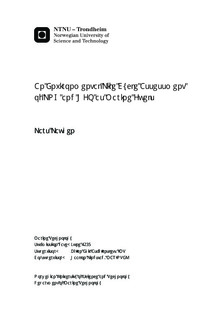| dc.description.abstract | The maritime transportation industry will face harder requirements from the international community when it comes to environmental issues. The introduction of Emission Control Areas (ECAs) has forced shipowners to rethink their fuel strategy and start looking for other solutions. To address the requirements from the International Maritime Organization (IMO), the shipping industry will either have to change from low quality fuel to more environmental friendly fuels, or introduce reductions techniques to handle their emissions. However, the environmental impact of a fuel is not only related to the combustion in the engine, but also to the whole life cycle starting at the well. This means that at a fuel that seems favorable in the combustion phase, may have large environmental impacts in the upstream process or vice versa. The overall aim of this thesis has been to compare liquefied natural gas (LNG) and heavy fuel oil (HFO) as marine fuels when it comes to their environmental performance in a life cycle perspective. This has been done by performing a life cycle assessment (LCA). A LCA is a management technique which addresses the environmental aspects and potential environmental impacts throughout a product?s life cycle. The selected impact categories for the LCA were global warming potential (GWP), acidification potential and primary energy use. The case studied was the use of LNG and HFO as marine fuels in passenger ferries out of Rotterdam. The natural gas were assumed to come from Statoil?s Melkøya plant in Norway and transported on a LNG carrier to Rotterdam. The HFO were assumed to be extracted as crude oil in the North Sea, transported to a refinery on the west coast and then transported on an oil tanker to Rotterdam. The functional unit of the study was set to transporting one ton cargo one km with a passenger vessel. Allocation issues with the LCA methodology have been solved by using lower heating values (LHV).The results from the studied case show that LNG is marginally better compared to HFO when it comes to the environmental impact over a life cycle. The total emissions were calculated to be 127 g CO2-eq/ton km and 130.13 g CO2/ton km for LNG and HFO respectively. It is also shown that the major contribution to global warming potential is during the combustion of the selected fuels. During this phase, approximately 70% of the total GHG emissions from the whole chain are released. The methane emission for the LNG pathway is eight times higher compared to the HFO pathway and accounts for 20% of the total GHG emissions for LNG. Since most of this is during combustion, it means that the performance of the engines plays a major part in the overall performance of LNG as a marine fuel. A small increase in the methane slip will increase the environmental footprint for LNG consequentially. For the acidification potential, LNG is the favorable fuel with 92% less emissions than HFO. In addition, LNG as fuel will meet the new regulations from IMO with maximum limit of sulphur in the fuel and the strictest NOx regulation, Tier III. The total primary energy use was calculated based on LHV, and LNG from Melkøya were found to be the most energy effective fuel with a total life cycle energy use of 1.33 MJ/ton km, while HFO has a lower efficiency with 1.81 MJ/ton km. When the primary energy use is combined with GWP and acidification potential, it becomes clear that not only is LNG more energy efficient, but it also releases less CO2 and SO2 equivalents than HFO in a life cycle perspective. | nb_NO |

